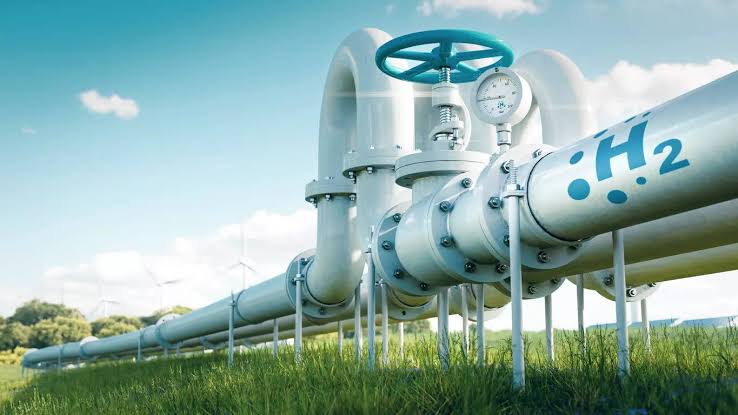Green hydrogen: Prospects and constraints for Nigeria’s energy transition.

It is no longer news that the “coolest kid on the block right now” as concerning clean energy technologies is Green Hydrogen. Regarded as the cleanest hydrogen from the different cadres of hydrogen production outlays that are represented by different colors such as blue, grey, black, brown, turquoise, yellow, and white hydrogen, green hydrogen is produced from hydrogen through the splitting of water using renewable energy-produced electricity in a process called electrolysis. Using this process, the production process of green hydrogen has no form of carbon footprint, highlighting its position as the cleanest form of energy and one of the frontline options that can be used to decarbonize “hard to abate sectors” such as petrochemicals and steel, steel and cement industry and deep-sea shipping, etc. In other words, green hydrogen provides a viable alternative that can help in the decarbonization of long-haulage transportation, industrial sectors (such as ammonia and steel), aviation, and shipping. Furthermore, green hydrogen finds strong application in its use for electricity production in mini and off-grid settings, highlighting its use for the electrification of rural areas.
Its reputation as the coolest kid on the block has endeared it into conversations about Nigeria’s energy transition plan that seeks to make Nigeria to be carbon-neutral by 2060. In fact, there are ongoing plans by critical stakeholders in Nigeria’s energy sector to develop a guideline for green hydrogen production, showcasing the importance of green hydrogen production in achieving Nigeria’s energy transition plan as outlined by the former Vice President of Nigeria, Prof. Yemi Osinbajo. In spite of the key role of green hydrogen in driving the transition from a carbon fuel-based economy to a clean energy-based economy in Nigeria, there is a big white elephant in the room that needs to be addressed – the cost of green hydrogen production.
Currently, it is estimated that the cost of producing 1kg of green hydrogen is between ₦3,292 - ₦4,938 (at an exchange rate of ₦823/USD1 as of 25-06-2023). Findings show that 1kg of green hydrogen produces 1 megawatt hour at a cost of ₦65,840 while some findings report a range of ₦82,300 - ₦164,600 (at an exchange rate of ₦823/USD1 as of 25-06-2023), a value that is 2.86 times higher than the current cost of a 1-megawatt hour of electricity in Nigeria at ₦23,000 that is produced from natural gas (adopting the lower cost of ₦65,840/ megawatt hour).
This begs the question: can the Nigerian economy pay for this high cost of electricity from green hydrogen for rural electrification projects in a bid to address the weighty issue of energy poverty? While this question is rhetorical in this context, the need to seek absolute clarity is hinged on the fact that findings show that the significant drop in the projected cost of green hydrogen production by 2050 (which is estimated at about ₦1234.5 per 1kg of green hydrogen), that has made it attractive for decarbonization, is hinged on a drop in process parameters such as cost of renewable energy and electrolyzers whose cost dynamics are largely unpredictable. According to a report by CRU, the ambitious use of green hydrogen to drive carbon neutrality by 2050 as indicated by different countries (Nigeria inclusive) is based on a 75% reduction in the CAPEX (capital expenditure) of electrolyzer systems and a 65% drop in the cost of renewable within the nearest future. While this is achievable in countries and regions such as EU, UK and China due to how their energy sector provides incentives that make low-carbon technologies attractive for investment thereby facilitating drop in cost, the financial indices of the Nigerian energy sector dynamics such as cost of carbon emissions meant to be incurred by companies that are carbon-intensive may not be at levels which would give cost advantage to green hydrogen production in the nearest future.
Considering these volatilities, the buzz around production and utilization of green hydrogen in the grand scale of energy transition in Nigeria becomes rather aspirational than substantive. This is particularly based on the fact its deployment within Nigeria’s economy faces huge financial implications, which is rather burdensome to the current Nigerian economy that is seriously debt-ridden. This assertion is corroborated by the fact that Namibia (that has a smaller economy compared to Nigeria) which is also looking at deployment green hydrogen at a large scale in their economy needs about ₦156.37 trillion by 2040 to achieve this target (at an exchange rate of ₦823/USD1 as at 25-06-2023). Juxtaposing this to the Nigerian economy, it becomes evident that the ambition of deploying green hydrogen in a large-scale bears dire economic consequence in terms of worsening the country’s debt profile. In essence, the dream of using green hydrogen in Nigeria for its ambitious energy transition plan faces a significant cost question that is yet to be clearly answered.
Jul 20, 2023 by Engr. Ogheneganre Eyankware
Other Articles
-
RemTrack Plog
Tinubu's ‘Green’ Mobility Directive: All You Need to Know About the Shift to CNG Vehicles
- RemTrack Plog
-
RemTrack Plog
ANALYSIS: Emerging Regulation of Sustainability Reporting in Nigeria
-
RemTrack Plog
INSIGHT: Sustainability as the New Deal for Companies and Communities
- RemTrack Plog
- RemTrack Plog
